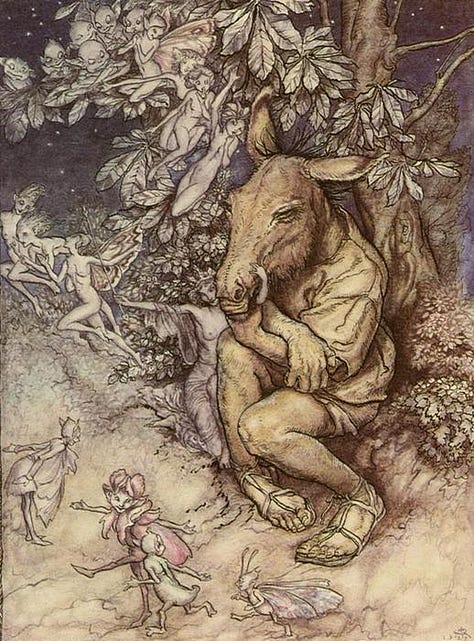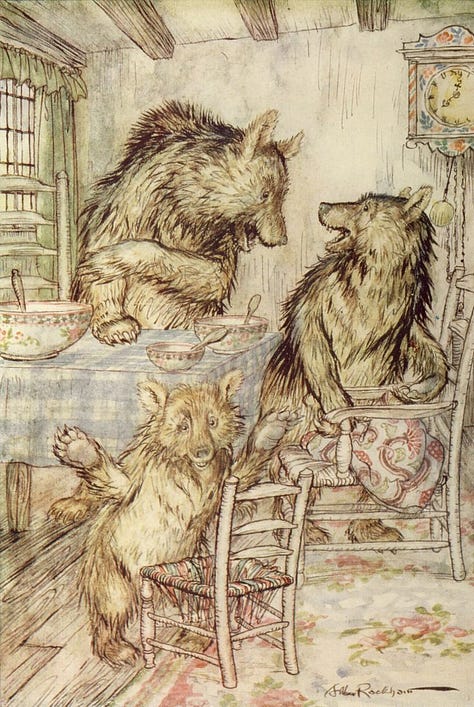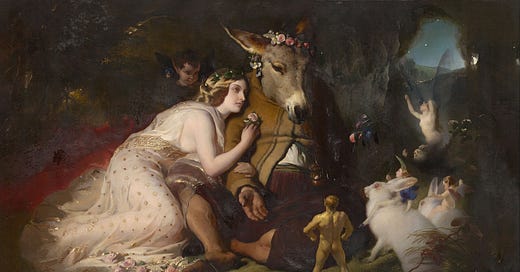Several months ago I was listening to a BookTuber discuss fairies in fiction (I wish I could remember which YouTuber). I scrolled down to the comments and saw someone say they could always tell when an author knew nothing about fairy folklore if the fairies in the story were capable of lying, because, they claimed, it’s a hard and fast rule that fairies cannot lie.
This surprised me. I happen to know a thing or two about fairy folklore, and I’ve never come across this rule. In fact, in most traditions I’m familiar with, fairies are not only capable of lying, they seem to take great joy in it.
The list of the ways fairies deceive humans is endless in folklore. They’ll give you gold or jewels, only for it to turn into leaves or dirt in the light of day. They’ll lure you into a grand, candlelit hall full of feasting and music, only for you to find, the next morning, you’re alone in a cold, dripping cave. They’ll even steal your baby and replace it with a lookalike changeling, a wizened fairy creature only pretending to be your child. And they seem to do all these things for their own amusement. What’s fairy mischief, after all, without a trick or two?
Whene'er such wanderers I meet, As from their night-sports they trudge home, With counterfeiting voice I greet, And call them on with me to roam: Through woods, through lakes; Through bogs, through brakes; Or else, unseen, with them I go, All in the nick, To play some trick, And frolic it, with ho, ho, ho! Sometimes I meet them like a man, Sometimes an ox, sometimes a hound; And to a horse I turn me can, To trip and trot about them round. But if to ride My back they stride, More swift than wind away I go, O'er hedge and lands, Through pools and ponds, I hurry, laughing, ho, ho, ho! ~ Anonymous
I wonder if this idea that fairies can’t lie might go all the way back to old ballads like Tam Lin, where the human heroine is told to “tell no lie” during a magical trial. But even there, it’s not the fairies who are bound to the truth; it’s the human who must speak honestly in the face of enchantment. Still, ballads like this, along with the fairy tendency to stick to bargains, may have helped inspire modern fantasy authors to invent the idea that fairies can’t lie. In Holly Black’s books, for example, the fae are incapable of lying outright, although they do twist words or speak in half-truths instead. It’s a fun trope that creates all kinds of opportunities for clever humans to trap or outwit the fairies.
One of my favourite moments in modern fantasy involving this sort of tricky logic is from the movie Labyrinth. In it, the main character Sarah encounters two strange, fairy-like creatures, one of whom always tells the truth, while the other always lies. And she’s only allowed to ask one of them a question to find the correct path.
It’s lucky for Sarah that one of them does indeed tell the truth, or else she’d never have figured out the way to go. But that film is also positively filled with fairy-like characters lying and deceiving. Even the Labyrinth itself is one big, shifting deception. To me this is much more in line with fairy-nature as I understand it than any supposed rule that fairies must always be truthful. As an aside, the fairies in my novel The Ghosts of Nothing absolutely can lie and often do. In fact, as I continue writing this series, I am finding that in some scenes, even I’m not sure if they’re telling the truth.
So yes, in folklore fairies do lie. Not always with words, but with what they show us, what they give us, and what they present themselves to be.
Which brings me to shapeshifting.
In folklore, the fairies have been known to take on a myriad of forms. They may appear as a handsome man or beautiful woman who vanishes into mist; a wild horse on the moor that lures you onto its back and then races you into a river for drowning; or a house cat that accepts your food and pampering only to one day fly up the chimney.



But the thing about fairy deception is that it isn’t always perfect. The devil, in some stories, is given away by his cloven hooves. And in fairy lore, the beautiful stranger dancing in the circle also sometimes has … hooves. Or a tail. Or feet turned backwards. Or something off about the eyes.
A glitch in the glamour? Or is it something else, a glimpse, perhaps, of what they truly are?
There’s a theory I’ve come to love: that fairies don’t have a human spirit in the way we understand it. That they’re not merely pretending to be part-animal, part-wild. That the hoof or the tail isn’t a slip-up, it’s a confession. A marker of the fact that they are, at least in part, other. Not of the village or the hearth fire, but of the woods and wind, of bog and beast. They are animal in some essential way: not tame, and not entirely knowable either. This may be why you can't always reason with a fairy. Sometimes, like if you encounter a wild animal, you can only survive them.
And fading, like that varied gleam. Is our inconstant shape. Who now like knight and lady seem, And now like dwarf and ape. ~ Walter Scott
This month’s video features eight stories from people who believe they’ve encountered one of these fairy shapeshifters, an eerie, trickster spirit who slips between forms and never shows you quite the same face twice. It does make you wonder if the animals in your life might have a second nature they only reveal when you’re fast asleep.
For me fairy trickery is one of the most interesting things about them, because I think their deceptions actually tell us something true about who and what they really are in the same way that fiction, when done well, is a lie that tells us the truth about some aspect of human nature.
What do you think? Can fairies lie? Let me know in the comments. I’d love to hear your take.
🍄 Featured Artist
This month’s featured artist is Lisa Blackwood and her book Ishtar's Blade. This book is an adventure/romance, and while it doesn't involve fairies directly, it does involve gryphons, which is pretty cool and an original fantasy world. This is the first book of a complete series, too, so there is much more to read if you like it. Check it out here: https://buy.bookfunnel.com/7k6n26dvgq?tid=ot9f2vrok5
Until next time,
Your Scary Fairy Godmother
P.S. If something beautiful beckons you from the woods, remember to check its feet.





I want your book
“Can fairies lie?”
Yes, and No, and NA. I think that the visible fairies are hallucinatory representations of the presence of a kind of intelligence that exists in a way that we cannot easily fathom, and so the mind creates a dreamish hallucinatory representation which is usually aligned with local cultural stories.
Otherwise a human mind can become somewhat temporarily for whatever reason (by means of psychedelics, other substances, extreme fever, extreme stress, lack of sleep, or prolonged fasting) temporarily extra permeable to the influence of such forms of intelligence.
With psychological boundaries weakened, the mind can thereby become somewhat more permeable to / interpenetrated by another intelligence and its will, and while blended one could be coaxed by the “fairy” or some body-less spirit or weirdly embodied diverse form of intelligence to perceive an image that accords with how it prefers to be seen, heard, witnessed, or known.
It’s so hard to generalize. Maybe some “fairies” are wise and honest while others lie and mislead, but each kind is not necessarily super geniuses about all things: they would have gaps in their understanding, and their moral sense is different, and they don’t possess experience-based knowledge about long term material and financial survival in a capitalist society, and they prioritize their own goals, so it’s likely best to doubt their assertions, to presume that while communicating their overriding purpose most likely is by default about influencing / advancing their goals moreso than truth-telling as such, like a charming narcissistic politician might do, funnily enough. And fairies can (like human beings) be confidently wrong.
It might be a trick question or a grammatical fluke as in they “can’t lie” because they can’t tell the truth either... in some cases their whole relation to truth and material reality itself is fundamentally other.
Anyway I can truthfully acknowledge that I have done a few posts about this topic, but it’s been predominately exploratory writing rather than scholarly / historical, and centered around “diverse forms of intelligence” more generally thus far with fairies being more like a niche phenomenon within the overarching potentially unbounded category of diverse forms of intelligence (such as human beings, artificial intelligence, plants, animals, birds, fish, insects, neurons, bacteria, swarms, mobs, ecosystems, economic systems, corporations, spirits including potentially the Holy Spirit, jinn, aliens, UFOs/UAP, fairies, neurons, “anthrobots,” thought-provoking quotes from Michael Levin).
Coincidentally, I can’t say for sure wether my own writing about novel forms of intelligence is “true” either because I haven’t been doing scholarly/historical writing, more like just casually brainstorming while hoping to synthesize a lot of disparate notions that might not actually belong together. And yet it feels like there could be a useful synthesis on the horizon and/or a framework in which they do all fit together relatively well.